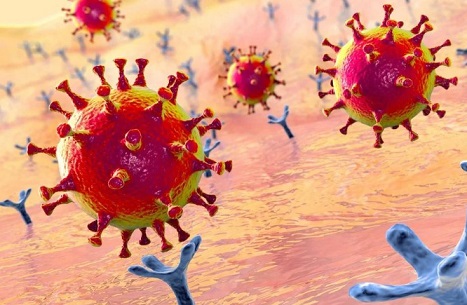Nikhil Prasad Fact checked by:Thailand Medical News Team Jul 12, 2024 9 months, 3 days, 14 hours, 50 minutes ago
COVID-19 News: Researchers from the University of Texas at El Paso-USA and Howard University-USA have uncovered fascinating details about the binding mechanisms of spike proteins from SARS-CoV and SARS-CoV-2 (the virus responsible for COVID-19) to the human ACE2 receptor. This
COVID-19 News report delves into their discoveries and what it means for future treatments.
 New insights into SARS-CoV-2 spike protein binding mechanisms
The Importance of Spike Proteins
New insights into SARS-CoV-2 spike protein binding mechanisms
The Importance of Spike Proteins
Spike proteins play a crucial role in the ability of coronaviruses to infect human cells. These proteins attach to the ACE2 receptors on human cells, allowing the virus to enter and begin its replication process. Understanding the differences in how these spike proteins function in SARS-CoV and SARS-CoV-2 is vital for developing effective treatments and vaccines.
The Study’s Approach
The research team used advanced computational methods to study the electrostatic interactions between the spike proteins of both viruses and the ACE2 receptor. By analyzing the electrostatic potential, electric field lines, and binding forces, they could compare how each virus interacts with ACE2.
Key Findings
-Electrostatic Attraction: Both SARS-CoV and SARS-CoV-2 are attracted to the ACE2 receptor through electrostatic forces. However, the specific residues (parts of the protein) that contribute to these forces differ due to mutations between the two viruses.
-Stronger Binding in SARS-CoV-2: SARS-CoV-2 binds to the ACE2 receptor more robustly than SARS-CoV. The electric field lines are distributed differently, resulting in stronger interactions between SARS-CoV-2 and ACE2.
-Key Residues: The study identified crucial residues involved in forming salt bridges and hydrogen bonds between the spike proteins and ACE2. These findings are essential for future drug design.
Why SARS-CoV-2 Spreads Faster
One of the significant insights from this study is why SARS-CoV-2 spreads more rapidly and affects more people compared to SARS-CoV. The stronger binding mechanism of SARS-CoV-2’s spike protein to ACE2 could be a key factor.
Detailed Analysis of Electrostatic Surfaces
The researchers utilized the DelPhi program to calculate the electrostatic potential of the S protein RBDs and ACE2. The electrostatic surfaces of the spike proteins from both viruses showed that the binding interface of ACE2 is dominantly negative, while the binding interfaces of the spike protein RBDs are all dominantly positive. This means that the spike proteins are naturally attracted to the ACE2 receptor, facilitating the infection process.
The study found that the SARS-CoV-2 spike protein has a higher electric field line density compared to SARS-CoV. This indicates a stronger interaction between SARS-CoV-2
and ACE2, which might explain why COVID-19 spreads more easily and infects a larger population.
Molecular Dynamics Simulations
To further understand the dynamic interactions, molecular dynamics (MD) simulations were carried out. These simulations showed that the spike proteins and ACE2 maintain strong interactions at various distances, further supporting the robust binding mechanism of SARS-CoV-2.
Key Residues and Binding Forces
The study identified several key residues that form salt bridges and hydrogen bonds between the spike proteins and ACE2. For SARS-CoV, residues like ARG426, ASP468, LYS390, and LYS465 were significant. In SARS-CoV-2, residues like ARG121 and LYS134 were crucial.
The electrostatic binding forces between the spike proteins and ACE2 were analyzed, revealing that SARS-CoV-2 has a more concentrated distribution of salt bridges and hydrogen bonds. This concentrated distribution likely contributes to its stronger binding affinity.
Implications for Drug Design
The differences in binding strategies between SARS-CoV and SARS-CoV-2 offer valuable information for developing drugs and vaccines. Targeting the specific residues and mechanisms that enhance SARS-CoV-2’s binding to ACE2 could lead to effective treatments for COVID-19. The study highlights potential targets for drug design, aiming to disrupt the interaction between the spike protein and ACE2.
Conclusion
The study provides a deeper understanding of the fundamental differences in how SARS-CoV and SARS-CoV-2 interact with human cells. This knowledge is crucial for developing strategies to combat COVID-19 and future coronavirus outbreaks. The more robust binding mechanism of SARS-CoV-2’s spike protein to ACE2 could be the key to its rapid spread and high infectivity.
The study findings were published in the peer-reviewed journal: Frontiers in Molecular Biosciences.
https://www.frontiersin.org/journals/molecular-biosciences/articles/10.3389/fmolb.2020.591873/full
For the latest
COVID-19 News, keep on logging to
Thailand Medical News.
Read Also:
https://www.thailandmedical.news/news/breaking-sars-cov-2-also-binds-to-histamine-receptor-h1-for-cell-entry
https://www.thailandmedical.news/news/breaking-news-scientists-discover-that-spike-protein-of-omicron-and-its-sub-lineages-binds-with-actin
